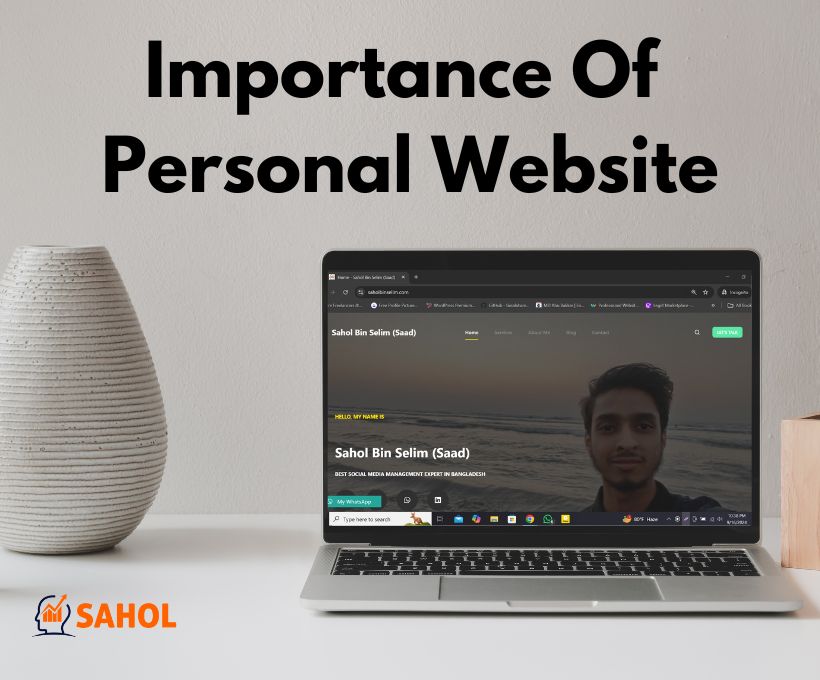Why Every Professional Needs a Personal Website: Step-by-Step Guide How to Create One
In today’s Digital-first world, having an online presence is no longer optional — it’s essential. Whether You are a freelancer, corporate employee, or entrepreneur, a personal website can significantly boost Your professional image and expand Your opportunities. In This article explores the importance of having a personal (portfolio) website and provides a step-by-step guide on How to create a Personal Website, even if you’re not tech-savvy.
Why Does Every Professional Need a Personal Website?
1. Personal Branding

Your personal website acts as a Digital Portfolio, highlighting who You are, what You do, and why people should care. It is your own space on the internet, unlike social media platforms, where you can show your professional image without the constraints of algorithms or changing policies.
2. Control Over Your Content
Social media accounts are great for networking, but they come with limitations. You don’t own Your LinkedIn profile or Instagram page — the platforms do. With a personal website, You have Total control over the content, design, and how You present Yourself. This enables you to tailor Your message specifically to your audience.
3. Showcasing Your Skills and Achievements
A personal website allows you to present Your portfolio, projects, and achievements in a way that fully highlights your capabilities. Whether you’re a corporate employee, designer, developer, marketer, or business leader, showcasing your skills on a website enhances your credibility and professionalism.
4. Strong Visibility
When potential employers or clients search Google for your name, what do they find? A personal website with well-optimized SEO can be the first result, ensuring that the image you want to project is seen first. This creates a professional impression before You even meet someone in person or via email.
5. Networking and Collaboration
A personal website makes it easy for like-minded professionals to connect with you. You can include a contact form, blog posts that grow engagement, or even links to your social media profiles. This opens the door to potential collaborations, partnerships, and job opportunities.
Step-by-Step Guide: How to Create a Personal Website
Now that you know why having a personal website is crucial, let’s walk through how you can create one.
1. Choose Your Domain Name

Your domain name is the web address people will use to find your site, and it should reflect your personal brand. If possible, use your full name (e.g., www.YourName.com). If your name is common or already taken, consider using a variation like adding your profession or niche (e.g., bdtechdiary.com).
Key Tips:
- Keep it short and memorable.
- Avoid numbers or special characters.
- Use a “.com” or “Me” extension if possible.
2. Pick a Web Hosting Provider
A web hosting provider is where your website’s files will live. There are many affordable and reliable hosting services to choose from, including:
- ExonHost: Best Web Hosting Provider In Bangladesh Great for beginners with 24/7 customer support.
- LimdaHost: Known for its speed and excellent service.
- Hostinger: Cheap Best Hosting provider. Affordable with a user-friendly interface.
Most hosting services also offer a free domain name for the first year, making it easier to set up.
3. Choose a Website Builder or CMS (Content Management System)
Next, You’ll need to choose a platform to build Your site. If you’re new to web design, consider using a drag-and-drop website builder. Here are some of the Good options:
- WordPress: The most popular CMS, offering vast customization options.
- Wix: User-friendly with beautiful templates.
- Squarespace: Known for visually stunning, professional-looking websites.
These platforms offer pre-built templates, so you don’t need coding skills to create a professional-looking website.
4. Select a Template and Customize Your Design
Once you’ve chosen your platform, the next step is to pick a template or theme. Most website builders offer hundreds of templates tailored to various industries. When selecting a template:
- Make sure it’s Your personal brand.
- Choose one that is mobile-responsive, ensuring it looks good on both smartphones and tablets.
- Customize the template to match your color palette, fonts, and layout preferences.
5. Create Key Pages
Now, it’s time to Publish Your website with content. These are the essential pages you should have:
- Home Page: Introduce Yourself with a professional photo, a brief bio, and a clear description of what you do.
- About Page: Dive deeper into your career summary, skills, and what sets you apart.
- Portfolio or Projects Page: Showcase your work with detailed examples, links & client Reviews.
- Blog (Optional): Share your thoughts, expertise, and industry insights to engage your audience and improve your website’s SEO.
- Contact Page: Include a contact form or email address for inquiries, and links to your social media profiles.
6. Optimize Your Site for SEO
Search engine optimization (SEO) is important for helping peoples find your website. You want your site to rank well in Google, Bing, and other search engines. Here are some basic SEO practices:
- Use Relevant Keywords: Include keywords relevant to your profession throughout your site, especially in page titles and headings.
- Optimize Images: Use descriptive filenames for images, and compress them to ensure fast loading times.
- Add Meta Descriptions: Write concise and compelling meta descriptions for each page to improve click-through rates.
7. Make It Mobile-Friendly
More than half of all web traffic comes from mobile devices, so Your website must look great on smartphones and tablets. Most website builders automatically make your site responsive, but be sure to check how each page looks on smaller screens before launching.
8. Publish and Promote Your Website
Once your website is 100% ready, hit the “Publish” button! After going live, you can promote it on Your social media channels, include the link in your email signature, and add it to your LinkedIn profile. Regularly update best content to keep it fresh and relevant.
Conclusion
In today’s competitive landscape, a personal website can be your secret weapon for standing out in your field. It helps you build a personal brand, showcase your skills, and control your online narrative. By following this step-by-step guide, you can create a professional website that elevates Your career and opens new doors.
Don’t wait — take charge of your online presence today!
